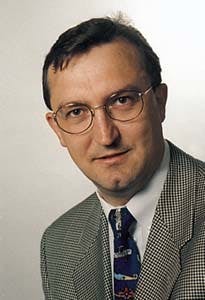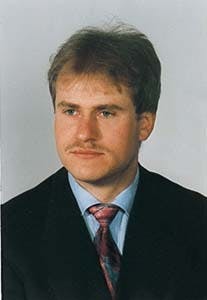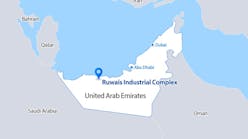Manfred Kass, Jens-Christian SengerDifferential sticking and formation damage were avoided in Germany's Uelsen gas field by drilling with low-head drilling (LHD) fluids.
BEB Erdgas & Erdöl GmbH
Nienhagen, Germany
Manfred Sach
Nowsco Well Service GmbH
Vechta, Germany
Uelsen is operated by BEB Erdgas & Erdöl GmbH in Germany and is being converted into an underground gas storage (UGS) facility. It is located northwest of Nordhorn near the Netherlands border.
Four storage wells were drilled and completed using the LHD technique in the depleted Bunter sandstone reservoir. A gradient of 0.6 bar/10 m (0.265 psi/ft) was achieved using an aerated mud system. This was the first time this type of system was used in Germany.
Drilling began in September 1995, and by spring of 1996, all four wells were drilled and completed. The injection test phase for the UGS project began Mar. 3, 1997.
The storage reservoir is the Detfurth sandstone. This horizon is located at a TVD of 1,500 m (4,920 ft) with an average horizontal depth of 2,000 m (6,560 ft). The storage reservoir is 86-141 m (282-462 ft) thick with liners placed in the reservoir at inclinations of 30-50°.
Low-head drilling
LHD is the process of drilling a subhydrostatic reservoir with drilling fluid pressures just above the reservoir pressure. It is different than underbalanced drilling (UBD), in that UBD creates a condition where the drilling fluid pressure is less than the formation pressure.One way to achieve a low drilling-fluid pressure is to use light-weight, oil-based muds with density gradients as low as 0.8 bar/10 m (0.354 psi/ft). If the reservoir pressure is less than 0.8 bar/10 m, as is the case at Uelsen, then an alternative process must be used.
Using LHD technology became less of a drilling problem and more of an hydraulic-fluid problem because of the difficulties in maintaining the complex fluid properties needed to ensure sufficient hole cleaning and controlling fluid losses into the underbalanced reservoir. Experience has shown that LHD can minimize reservoir losses but cannot avoid them altogether. With the reduction of fluid losses, the probability of formation damage is minimized, and subsequent expensive reservoir stimulation measures can be prevented.
At Uelsen, cost reductions gained from reduced mud losses were obvious. However, the prevention of differential sticking became the most important, intangible benefit. The LHD process reduced the differential pressure between the fluid column and the formation. In addition, the absence of a thick mud cake diminished the risk of wall sticking and subsequent fishing jobs.
A negative aspect of the LHD process was the high cost needed to use the technology, originally estimated at $300,000/well. Unfortunately, the final costs exceeded this value because some operations required the LHD equipment to be placed on stand-by.
Unfortunately, increased bit performance resulting from reduced pressures at the bit was not relevant because the drilling program contained numerous coring runs and relatively short drilling intervals.
Mud systems
The estimated bottom hole pressure (BHP) gradient in Uelsen was 0.45-0.65 bar/10 m (0.198-0.287 psi/ft). To eliminate or reduce the risk of losing mud into the reservoir, or plugging it up with lost-circulation material, alternative mud systems were studied including foam, gas (nitrogen), and muds which form mud cakes on the well bore.Foam muds were excluded because they would not remain stable during the drilling process, and because their pressure gradients would create a condition of UBD (0.15 to 0.40 bar/10 m). The mud cake option was rejected because of the possibility of formation damage and the fact that the gradient could not be maintained lower than 0.8 bar/10 m (0.354 psi/ft), a condition of excessive overbalance.
Therefore, the solution was a potassium chloride (KCl) water-based mud mixed with nitrogen. This allowed for the use of a solids-free mud with a pressure-gradient operating range of 0.35-0.80 bar/10 m (0.155-0.354 psi/ft); thereby minimizing the possibility of formation damage. Thus, the drilling operation could be carried out in a slightly overbalanced condition.
There were two options available to achieve the desired fluidization of the mud. The first option included the use of a parasitic or external tubular string that would inject nitrogen into the annulus. The second option was to use back-flow valves in the drillstring and inject the nitrogen into the drillstring.
The second option was selected for the project. The mud returns (nitrogen-liquid mixture) were fed into a three-stage separator (Fig. 1 [26,436 bytes]). A rotating BOP (RBOP) was mounted for well control. In addition, a memory pressure gauge was placed in the drillstring providing post-drilling pressure information.
LHD management
LHD is substantially different than standard drilling processes and needs different management procedures. The key problem is to control the BHP and continuously maintain the pressure within a specified range. System design, the use of "fit-for-purpose" procedures, and communication between the involved parties are the three most important issues of LHD management.The design effort focused specifically on the hydraulic system. The main design considerations were the BHP and the derived surface parameters consisting of pressure, volume, and gas-liquid composition. Further design considerations included:
- The annular flow regime (slug, bubble, or mist flow)
- Turbulent annular control levels
- Segregation of liquid and nitrogen in the drillstring and annulus
- The pumping volumes, pressures, and temperatures
- Nitrogen and liquid distribution in the annulus
- Liquid levels in the well
- Resulting annular and drillstring pressures during drilling.
The BHP was defined by the reservoir pore pressure. In the drilling program at Uelsen, a 10-50 bar (145-725 psi) overbalance above reservoir pressure was instituted. Fig. 2 [38,734 bytes] shows the measured data of a bottom hole circulation pressure plot.
The correct BHP can be created within a range of liquid-gas ratios. However, the lifting capability of the nitrogen reduces this to a single-solution problem. In deviated or horizontal wells, the cuttings transport up the mud column can constitute a problem because of gas-liquid separation. The solution to this is to keep the flow of the mixture turbulent. A simulation software program was used to calculate volumes, pressures, and velocities necessary for the nitrogen injection.
"Fit-for-purpose" procedures
While drilling, the string and annulus were entirely filled with liquids and compressible nitrogen. When the pumps were shut down, the system did not behave in a static manner, but instead, liquid and nitrogen segregated because of their density differential.If the annulus was left open to the separator, nitrogen was allowed to expand, and some liquids were produced, causing a reduction in BHP. If the annulus was closed, then the nitrogen would percolate up and the BHP would increase. To manage this situation, procedures were instituted according to the following experience curve:
- Ream the last drilled single drill pipe.
- Stop the nitrogen pump and close the nitrogen-injection valve.
- Pump 1 cu m (6.29 bbl) liquid to compensate for the loss of volume above the top back-flow valve.
- Stop the liquid pump and close the line between the annulus and separator.
- Release the pressure above the back-flow valve and close the kelly valve.
- Connect-up a new drill pipe and open the kelly valve.
- Open the line between the annulus and separator, open the nitrogen-injection valve, start the liquid and nitrogen pumps.
- Start drilling as soon as the pressures become constant.
The controlled removal of the nitrogen prior to the pulling of a single joint of drillpipe was an important factor. While tripping, a predefined liquid volume was displaced in steps into the drillstring while nitrogen was simultaneously released from the annulus. This ensured the correct BHP.
After the removal of the single drillpipe, the BHP was known to be maintained within the specified range because the liquid level in the annulus dropped. In case of liquids losses, the lost volumes were circulated back into the well to prevent a kick.
The stepwise removal of the nitrogen out of the annulus was required to reduce the risk of differential sticking and provided a safe method for pulling the drillstring out of the hole. During this procedure, an accurate check of the in-out volume balance was needed for successful tripping. The advantage of this method was that the drillstring could be pulled out dry without jeopardizing the well or creating fluid losses.
From the described procedures detailed above, it was clear that the success of the process depended on optimal communications between the key operating staff. The use of walky-talkies provided a reliable means to communicate without misunderstandings. The communication protocol required that each and every instruction had to be confirmed by the receiving party.
Drilling costs
The use of the LHD process in the Uelsen underground gas storage project did not reduce drilling costs. However, without the use of this process, formation damage would have been unavoidable. There were no problems of stuck pipe for all four wells. This alone justified the use of the process because fishing jobs could have easily resulted in a cost of $500,000 or more.This means that LHD reduces the risk of stuck pipe, although the price of the process is higher than using overbalanced mud systems. In addition, because there was an absence of solids in the mud system, the formation damage was probably reduced significantly. Evidence of this will become available when injection and subsequent production starts later in 1997.
Operational experience
At Uelsen, it was demonstrated that controlled liquid-level reductions were achievable. After a short learning period, the LHD operation developed a fast learning curve and became a familiar process to the field personnel. UBD is used world-wide to prevent formation damage and differential sticking. LHD has demonstrated itself to be an effective process to control both aspects. However, formation impairment is not as controllable with the LHD process as compared to UBD methods.There were no LHD operational problems at Uelsen. There were only minor modifications made to the return line located between the tanks and separator. Liquid and nitrogen pressure ranges were maintained within their specified pressure tolerances (5-10 bar), and volumes were achieved by accurately controlling liquid and nitrogen pump rates.
To ensure sufficient hole cleaning, adequate annular velocities were needed, requiring minimum liquid volumes to be maintained in the well. The minimum achievable BHP was empirically defined by the required liquid-phase volume in the hole for effective hole cleaning, and it was found that it can be reduced to 0.35 bar/10 m (0.154 psi/ft) using a low-viscosity mud. The requirement for Uelsen was in the operating range of 0.45-0.7 bar/10 m (0.199-0.31 psi/ft).
Coring was executed with reduced BHPs. To prevent losses in the core barrel, the volumetric flow (fluid + nitrogen) through the core barrel was limited to 600 l./min (158.5 gpm). To ensure effective hole cleaning, operations included a reaming trip after each core run. Core recovery was not influenced by this procedure.
Because of the short hole sections, the amount of returned cuttings was limited. Therefore, it was not necessary to clean out the cutting from the separator for the entire duration of the well. As a consequence, the shakers could be bypassed. Because of the low mud viscosity, the desilters and desanders efficiently separated the solids from the liquids.
Completion criteria
In planning the completion operations, the following criteria were defined by the production and reservoir engineering groups:- Minimize formation damage.
- Prepare for the possibility of selective stimulations and temporary water shut-offs in the lower layer of the Detfurth sandstone.
The only adjustment to the low-head completion method was the use of nonslotted liners located between the ECPs instead of preslotted liners. This was in case of a kick, for it would not have been practicable to shut-in a well with a preslotted liner positioned within the BOPs. In addition, the nonslotted liners alleviated the need for a snubbing unit.
A liner was run to the 95/8-in. casing shoe, and the nitrogen-based mud was circulated through the drillpipe and liner in order to generate the desired mud gradient.
The liner was run to the total depth under these low-head conditions. By running a nonslotted liner, it was possible to separate the reservoir formation from the well bore completion fluid. This enabled BEB to run the tubing completion with a well bore entirely filled with the completion fluid, while isolating the reservoir pressure from the well bore pressure.
After hydraulic isolation of the reservoir and the well bore, the tubing and wellhead were installed using standard completion procedures. Perforations and production tests were conducted in the early part of 1997.
Future applications
LHD should be considered for the development of sour gas fields and in unconsolidated sand reservoirs. Even for traditional wells which are not underbalanced, the technology can be used to prevent differential sticking and reduce the risk of fishing stuck drillpipe. The functionality of the LHD process, which allows mud weights to be maintained in the range of 0.35-0.80 bar/10 m (0.155-0.354 psi/ft), makes this process an invaluable element in well design and drilling operations.The use of electromagnetic downhole telemetry tools may also provide real-time pressure readings at the surface. Unfortunately for the Uelsen four-well project, pressure quality control could only be achieved after the section was drilled and the drillstring was tripped out with the memory gauge.
Concerning low-head cementation processes, the aim of the process was to ensure a good bond between the pipe and cement. This was achieved by reducing the liquid level inside the casing so that the casing would contract during the cementation phase. After the cement hardened, the internal pressure of the casing was increased, resulting in an expanding force on the cement. Because of this force, the formation of a micro-annulus was prevented and was confirmed by cement bond log measurements. As a consequence, this process was applied to all wells with an additional cost of $6,500 per job.
Acknowledgment
The authors thank BEB Erdgas & Erdöl GmbH and Nowsco Well Service GmbH for permission to publish this article.The Authors
Manfred Kass is drilling engineer with BEB Erdgas & Erdöl GmbH in Nienhagen, Germany. He is the low-head drilling coordinator for the Uelsen underground gas storage project. Kass has a masters degree in drilling and production technology from Technical University of Clausthal, Germany, and has 9 years of experience in drilling and completion technologies.
Jens-Christian Senger is a completion engineer for BEB Erdgas & Erdöl GmbH in Nienhagen, Germany. He has been with BEB for more than 3 years. Senger received an ME degree from the Technical University of Clausthal, Germany. He was involved in the completion design as well as the operational aspects of the Uelsen underground gas storage project.
Manfred Sach is a drilling engineer with Nowsco Well Service GmbH in Vechta, Germany, and is currently working on underbalanced and low-head drilling projects using jointed pipe. Previously, he worked in Nowsco's coiled tubing group as a drilling operations engineer for 5 years. Sach holds a degree in drilling technology and fluid mining from the Technical University Mining Academy of Freiberg, Germany.
Copyright 1997 Oil & Gas Journal. All Rights Reserved.





